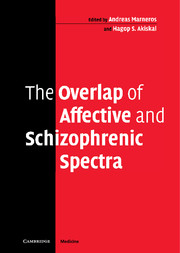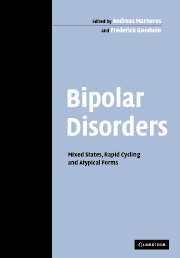48 results
Is the psychopathology of acute and transient psychotic disorder different from schizophrenic and schizoaffective disorders?
-
- Journal:
- European Psychiatry / Volume 20 / Issue 4 / June 2005
- Published online by Cambridge University Press:
- 16 April 2020, pp. 315-320
-
- Article
- Export citation
Psychiatry's 200th birthday
-
- Journal:
- The British Journal of Psychiatry / Volume 193 / Issue 1 / July 2008
- Published online by Cambridge University Press:
- 02 January 2018, pp. 1-3
- Print publication:
- July 2008
-
- Article
-
- You have access
- HTML
- Export citation
6 - Schizophreniform Disorder and Brief Psychotic Disorder: The Acute and Transient Psychoses
- from Part II - Primary Psychotic Disorders
-
-
- Book:
- The Spectrum of Psychotic Disorders
- Published online:
- 06 January 2010
- Print publication:
- 08 March 2007, pp 96-115
-
- Chapter
- Export citation
1 - The paradigma of overlapping affective and schizophrenic spectra: schizoaffective conditions
-
-
- Book:
- The Overlap of Affective and Schizophrenic Spectra
- Published online:
- 02 September 2009
- Print publication:
- 16 November 2006, pp 1-24
-
- Chapter
- Export citation
List of contributors
-
- Book:
- The Overlap of Affective and Schizophrenic Spectra
- Published online:
- 02 September 2009
- Print publication:
- 16 November 2006, pp vii-x
-
- Chapter
- Export citation

The Overlap of Affective and Schizophrenic Spectra
-
- Published online:
- 02 September 2009
- Print publication:
- 16 November 2006
Preface
-
- Book:
- The Overlap of Affective and Schizophrenic Spectra
- Published online:
- 02 September 2009
- Print publication:
- 16 November 2006, pp xi-xii
-
- Chapter
- Export citation
10 - The overlapping of the spectra: brief and acute psychoses
-
-
- Book:
- The Overlap of Affective and Schizophrenic Spectra
- Published online:
- 02 September 2009
- Print publication:
- 16 November 2006, pp 182-206
-
- Chapter
- Export citation
8 - Clinical course of schizoaffective disorders
-
-
- Book:
- The Overlap of Affective and Schizophrenic Spectra
- Published online:
- 02 September 2009
- Print publication:
- 16 November 2006, pp 145-155
-
- Chapter
- Export citation
Contents
-
- Book:
- The Overlap of Affective and Schizophrenic Spectra
- Published online:
- 02 September 2009
- Print publication:
- 16 November 2006, pp v-vi
-
- Chapter
- Export citation
Index
-
- Book:
- The Overlap of Affective and Schizophrenic Spectra
- Published online:
- 02 September 2009
- Print publication:
- 16 November 2006, pp 293-299
-
- Chapter
- Export citation
Frontmatter
-
- Book:
- The Overlap of Affective and Schizophrenic Spectra
- Published online:
- 02 September 2009
- Print publication:
- 16 November 2006, pp i-iv
-
- Chapter
- Export citation
Beyond the Kraepelinian dichotomy: acute and transient psychotic disorders and the necessity for clinical differentiation
-
- Journal:
- The British Journal of Psychiatry / Volume 189 / Issue 1 / July 2006
- Published online by Cambridge University Press:
- 02 January 2018, pp. 1-2
- Print publication:
- July 2006
-
- Article
-
- You have access
- HTML
- Export citation
¿Son las manifestaciones psicopatológicas del trastorno psicótico agudo y transitorio diferentes a las de los trastornos esquizofrénico y esquizoafectivo?
-
- Journal:
- European Psychiatry (Ed.Española) / Volume 12 / Issue 8 / November 2005
- Published online by Cambridge University Press:
- 12 May 2020, pp. 418-425
- Print publication:
- November 2005
-
- Article
- Export citation
Preface
-
-
- Book:
- Bipolar Disorders
- Published online:
- 10 August 2009
- Print publication:
- 06 October 2005, pp xi-xii
-
- Chapter
- Export citation
8 - Schizoaffective mixed states
-
-
- Book:
- Bipolar Disorders
- Published online:
- 10 August 2009
- Print publication:
- 06 October 2005, pp 187-206
-
- Chapter
- Export citation
1 - Bipolar disorders beyond major depression and euphoric mania
-
-
- Book:
- Bipolar Disorders
- Published online:
- 10 August 2009
- Print publication:
- 06 October 2005, pp 1-44
-
- Chapter
- Export citation

Bipolar Disorders
- Mixed States, Rapid Cycling and Atypical Forms
-
- Published online:
- 10 August 2009
- Print publication:
- 06 October 2005
Frontmatter
-
- Book:
- Bipolar Disorders
- Published online:
- 10 August 2009
- Print publication:
- 06 October 2005, pp i-iv
-
- Chapter
- Export citation
List of contributors
-
- Book:
- Bipolar Disorders
- Published online:
- 10 August 2009
- Print publication:
- 06 October 2005, pp vii-x
-
- Chapter
- Export citation



